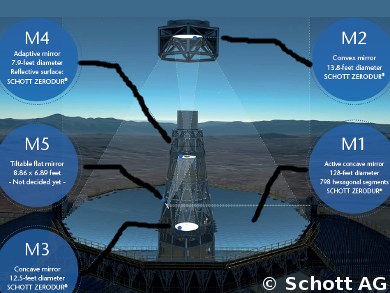With the Extremely Large Telescope (ELT), the European Southern Observatory (ESO) is creating a mega-telescope for more advanced space research. It is currently being built on Cerro Armazones, a mountain in Chile. In 2024, the world‘s biggest telescope will have the ability to “see” 15 times better than its predecessor. The interest in research is directed especially towards exoplanets, perhaps earth-like planets outside the solar system. New insights into the origin of the universe are also being hoped for.
Schott AG’s Zerodur® glass-ceramic is being used for the ELT’s mirrors. In Mainz, Germany, 949 round mirror carriers, 5 cm thick and with a diameter of 1.52 m, will be produced. From these, 798 hexagonal segments will be produced, from which in turn the main mirror (Mirror 1, short M1) with a diameter of 39 m will be composed. It is much too large to be cast in one piece. The second mirror M2 with a diameter of 4.25 m captures the light of the main mirror, bundles it, and passes it to a third mirror (M3). The light is directed to two further mirrors, which compensate disturbing influences such as the unrest of the atmosphere or the swaying of the telescope building in strong winds. The technique of adaptive optics is used, in which specially designed mirrors are moved quickly or deformed on their surface to compensate for real-time disturbances.
Zerodur®, a glass ceramic produced in a special process, is the material for the mirror support. Lithium oxide, alumina oxide and silicium oxide are the three main constituents. They are heated to above 1500 °C in a melting furnace. The mass is poured into a mold and then slowly cooled so that no stress is produced in the material. For ceramization, the glass block is heated again to over 700 °C. Tiny crystals grow in the glass phase. When these nanocrystals have reached the optimum number and size of 50–70 nm, the material is slowly cooled again. After a production time of several months, an amber, slightly opaque material characterized by evenly-distributed nano-crystals within a residual glass phase results. The glass expands upon heating, the crystals shrink, so the material has a very low coefficient of thermal expansion during temperature changes. The astronomers want to use the telescope all night. The usual temperature fluctuations would deform glass mirrors and lead to distorted images.
After production and grinding, the mirror carriers will be transported from Mainz to France. At Sarfan-Reosc, St. Benoît, they will get their final hexagonal shape and their polish. Lastly, the actual mirror layer made of aluminum or silver has to be vaporized. This is done on the top, contrary to what we know from bathroom mirrors, where the reflective layer is under the glass.
Technology such as the ELT must be able to capture as much light as possible before transferring it onto scientific instruments. To achieve this, the sizes of the mirrors are constantly increasing and the designs for them are becoming more complex.
- Schott AG, Mainz, Germany
- European Extremely Large Telescope: Glaskeramik für Rekordteleskop kommt aus Mainz,
Peter Zschunke, dpa 06.07.2017




